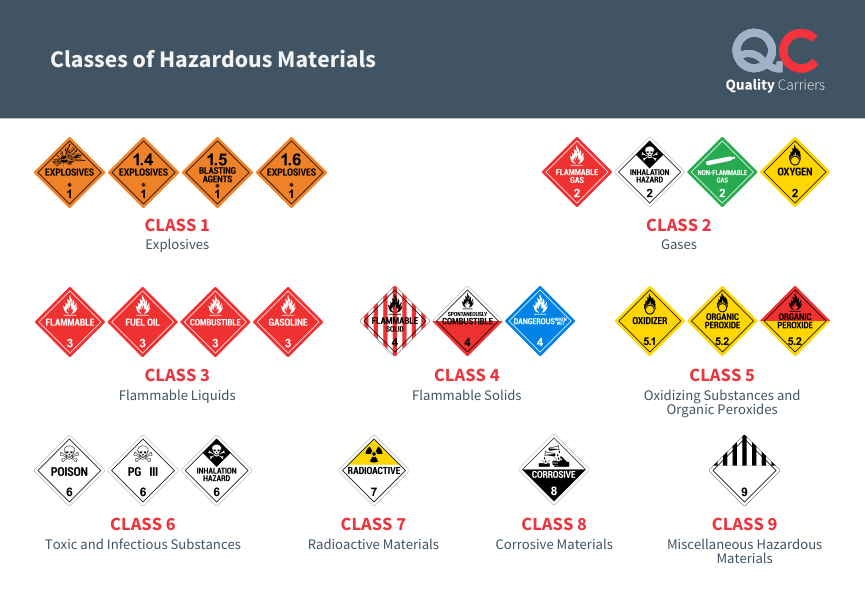“HAZMAT” often refers to hazardous materials in transportation and logistics. These materials are integral to many industries, including manufacturing, healthcare, and everyday life.
This blog post dives into what Hazmat means, why it’s essential, and the certifications and endorsements associated with handling these materials.
What Exactly is “HAZMAT”?
HAZMAT, or Hazardous Materials, is a term used to describe substances that, due to their chemical or physical properties, can potentially cause harm to people, property, or the environment. These materials can take various forms, including solids, liquids, gases, or mixtures. They range from common chemicals used in industrial processes to everyday household products. Examples of Hazmat substances include gasoline, explosives, radioactive materials, and toxic chemicals.
Classes of Hazardous Materials

The classification of hazardous materials is essential for safe handling, storage, and transportation. The U.S. Department of Transportation and other international organizations have established a system categorizing hazardous materials into classes or divisions based on their properties and potential risks. Here are the nine primary classes of hazardous materials:
Class 1: Explosives – This class includes materials that can detonate or explode, such as fireworks, ammunition, and dynamite. It’s further divided into six divisions based on the degree of danger.
Class 2: Gases – Gases that are compressed, liquefied, or dissolved under pressure fall under this class. Examples include propane, oxygen, and nitrogen.
Class 3: Flammable Liquids – Liquids with a flashpoint of less than 140°F (60°C) are considered flammable. Gasoline, ethanol, and diesel fuel are examples.
Class 4: Flammable Solids – This class encompasses solids that ignite when exposed to heat or friction. Some spontaneously combust when in contact with air or water. Examples include matches and powders.
Class 5: Oxidizing Substances and Organic Peroxides – These materials can release oxygen and support combustion. They include hydrogen peroxide and ammonium nitrate.
Class 6: Toxic and Infectious Substances – Substances that can be harmful or lethal when inhaled, ingested, or absorbed fall under this class. Examples include pesticides and medical waste.
Class 7: Radioactive Materials – Materials that emit ionizing radiation belong to this class. They are often used in medical and industrial applications.
Class 8: Corrosive Materials – Corrosive substances can destroy living tissue, metals, and other materials. Examples include sulfuric acid and caustic soda.
Class 9: Miscellaneous Hazardous Materials – This class covers hazardous materials that don’t fit into the previous eight classes but still pose risks. It includes items like lithium batteries and asbestos.
The Importance of Hazmat Certification
Given the inherent risks associated with transporting hazardous materials, stringent regulations and safety standards are in place to ensure the safe handling and transportation of Hazardous materials. One crucial aspect of these regulations is Hazmat Certification.
Hazmat certification is a specialized training program designed to educate individuals involved in transporting hazardous materials. It ensures that drivers, handlers, and anyone involved in the process know the risks and how to handle and transport Hazmat safely. This certification covers various topics, including identifying hazardous materials, understanding their properties, using the proper packaging and labeling, and responding to emergencies.
What is Hazmat Endorsement?
A hazmat endorsement is another qualification commercial drivers can obtain to transport hazardous materials. This endorsement is usually required for drivers who operate vehicles transporting Hazmat, such as chemicals or flammable materials. To obtain a hazmat endorsement, drivers must undergo a thorough background check and pass a written exam to understand the regulations and safety protocols associated with transporting hazardous materials.

Safety First: The Hazmat Transporter’s Responsibility
Transporting hazardous materials is a responsibility that should never be taken lightly. Hazmat transporters are crucial in ensuring these materials reach their destinations safely. They must adhere to strict guidelines, including proper packaging, labeling, placarding, and route planning. Safety precautions are paramount, and transporters are trained to handle emergencies, such as spills or accidents, with precision and care.
In conclusion, Hazmat, or hazardous materials, is a crucial aspect of various industries. Proper handling and transportation of these materials are vital for safety, compliance with regulations, and the smooth functioning of industries that rely on them. Hazmat certification and endorsement ensure that individuals are well-equipped to handle these materials responsibly and safely. Whether you’re a driver, a logistics professional, or work in an industry involving HAZMAT, understanding its significance and the associated certifications is essential for your career and the well-being of society.
FAQs about Hazmat
How Are Hazmat Materials Transported Safely?
Hazmat materials are transported safely by following strict regulations, including proper labeling, packaging, and placarding of containers, specialized training for drivers, and compliance with transportation laws.
Is There Training Available for Handling Hazmat?
Yes, training programs are available to educate individuals on safely handling hazardous materials. Many organizations offer Hazmat training courses and certifications for various industries.
Are There Regulations Governing the Transportation of Hazmat?
Yes, extensive regulations, such as those outlined by the U.S. Department of Transportation and Hazardous Materials Regulations (HMR), oversee the transportation of hazardous materials. These regulations ensure the safe transport of Hazmat.




